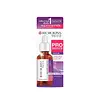What's inside
What's inside
 Key Ingredients
Key Ingredients

 Benefits
Benefits

 Concerns
Concerns

 Ingredients Side-by-side
Ingredients Side-by-side

Water
Skin ConditioningPropanediol
SolventGlycerin
HumectantNiacinamide
SmoothingCaprylic/Capric Triglyceride
MaskingPhenyl Trimethicone
Skin Conditioning1,2-Hexanediol
Skin ConditioningBifida Ferment Lysate
Skin ConditioningLactobacillus Ferment
Skin ConditioningCyclopentasiloxane
EmollientHydroxyacetophenone
AntioxidantButylene Glycol
HumectantAcrylates/C10-30 Alkyl Acrylate Crosspolymer
Emulsion StabilisingHydrogenated Lecithin
EmulsifyingSodium Hydroxide
BufferingAdenosine
Skin ConditioningDisodium EDTA
Sodium Hyaluronate
HumectantHamamelis Virginiana Extract
AntiseborrhoeicCI 14700
Cosmetic ColorantCI 19140
Cosmetic ColorantWater, Propanediol, Glycerin, Niacinamide, Caprylic/Capric Triglyceride, Phenyl Trimethicone, 1,2-Hexanediol, Bifida Ferment Lysate, Lactobacillus Ferment, Cyclopentasiloxane, Hydroxyacetophenone, Butylene Glycol, Acrylates/C10-30 Alkyl Acrylate Crosspolymer, Hydrogenated Lecithin, Sodium Hydroxide, Adenosine, Disodium EDTA, Sodium Hyaluronate, Hamamelis Virginiana Extract, CI 14700, CI 19140
Water
Skin ConditioningPropanediol
SolventGlycerin
HumectantDipropylene Glycol
HumectantAloe Barbadensis Leaf Juice Powder
Skin ConditioningAcetyl Glucosamine
Skin ConditioningPalmitoyl Pentapeptide-4
Skin ConditioningBiosaccharide Gum-2
Skin ConditioningPentylene Glycol
Skin ConditioningXanthan Gum
EmulsifyingIsoceteth-20
EmulsifyingHydroxymethoxyphenyl Decanone
Skin ConditioningSodium Lactate
BufferingLactic Acid
BufferingSodium Hydroxide
BufferingEthylhexylglycerin
Skin ConditioningPhenoxyethanol
PreservativeChlorphenesin
AntimicrobialWater, Propanediol, Glycerin, Dipropylene Glycol, Aloe Barbadensis Leaf Juice Powder, Acetyl Glucosamine, Palmitoyl Pentapeptide-4, Biosaccharide Gum-2, Pentylene Glycol, Xanthan Gum, Isoceteth-20, Hydroxymethoxyphenyl Decanone, Sodium Lactate, Lactic Acid, Sodium Hydroxide, Ethylhexylglycerin, Phenoxyethanol, Chlorphenesin
 Reviews
Reviews

Ingredients Explained
These ingredients are found in both products.
Ingredients higher up in an ingredient list are typically present in a larger amount.
Glycerin is already naturally found in your skin. It helps moisturize and protect your skin.
A study from 2016 found glycerin to be more effective as a humectant than AHAs and hyaluronic acid.
As a humectant, it helps the skin stay hydrated by pulling moisture to your skin. The low molecular weight of glycerin allows it to pull moisture into the deeper layers of your skin.
Hydrated skin improves your skin barrier; Your skin barrier helps protect against irritants and bacteria.
Glycerin has also been found to have antimicrobial and antiviral properties. Due to these properties, glycerin is often used in wound and burn treatments.
In cosmetics, glycerin is usually derived from plants such as soybean or palm. However, it can also be sourced from animals, such as tallow or animal fat.
This ingredient is organic, colorless, odorless, and non-toxic.
Glycerin is the name for this ingredient in American English. British English uses Glycerol/Glycerine.
Learn more about GlycerinPropanediol is an all-star ingredient. It softens, hydrates, and smooths the skin.
It’s often used to:
Propanediol is not likely to cause sensitivity and considered safe to use. It is derived from corn or petroleum with a clear color and no scent.
Learn more about PropanediolSodium Hydroxide is also known as lye or caustic soda. It is used to adjust the pH of products; many ingredients require a specific pH to be effective.
In small amounts, sodium hydroxide is considered safe to use. However, large amounts may cause chemical burns due to its high alkaline.
Your skin has a natural pH and acid mantle. This acid mantle helps prevent harmful bacteria from breaking through. The acid mantle also helps keep your skin hydrated.
"Alkaline" refers to a high pH level. A low pH level would be considered acidic.
Learn more about Sodium HydroxideWater. It's the most common cosmetic ingredient of all. You'll usually see it at the top of ingredient lists, meaning that it makes up the largest part of the product.
So why is it so popular? Water most often acts as a solvent - this means that it helps dissolve other ingredients into the formulation.
You'll also recognize water as that liquid we all need to stay alive. If you see this, drink a glass of water. Stay hydrated!
Learn more about Water